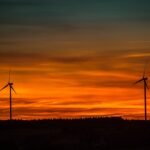The energy transition in Europe had a challenging year in 2023, with various industries struggling to survive and make progress. Wind and solar stocks were hit hard due to rising raw material costs, increased borrowing costs, and supply chain issues. Electric vehicle (EV) manufacturers faced affordability and reliability challenges, while China solidified its position as the world’s largest EV maker. Hydrogen remained a topic of discussion, but little progress was made. Unfortunately, this year is unlikely to be much different.
One of the main issues facing wind and solar power development is the persistent problem of high costs. The factors that contributed to these high costs are unlikely to change in the coming year. Wind and solar companies are more exposed to interest rate hikes compared to other energy companies, and they have less cash reserves to absorb the negative effects of these rate hikes. Last year, the European Central Bank implemented several interest rate increases to combat inflation, resulting in higher borrowing costs for companies that were already struggling financially. As a result, investors lost confidence and withdrew their support.
In contrast, oil and gas companies were able to generate sufficient cash flow to withstand the higher interest rates. These companies enjoyed a profitable year in 2022 as Europe shifted its focus from the energy transition to energy security.
According to Wood Mackenzie, the solar power industry saw a 23% increase in costs from 2022 to 2023, and other industries involved in the energy transition experienced similar cost increases. Rory McCarthy, a senior research manager at Wood Mackenzie, stated that the industry was unprepared for such drastic cost increases. Many projects became financially unviable, leading to reduced participation in renewable energy tenders organized by European governments. The prices offered at these tenders were too low for solar developers to sustain their operations.
The wind power industry faced similar challenges, resulting in project cancellations. Although there was a record increase in wind capacity additions in 2023, it was still modest compared to what is needed to meet the EU’s transition targets. The EU aims to install 30 GW of wind capacity annually, but the actual additions fell short of this goal.
The situation is not expected to improve this year, as the European Central Bank has announced that it will maintain interest rates at their current levels for the time being. Brussels continues to advocate for more state funding for wind and solar projects and urges member states to streamline approval and installation processes. However, progress has been slow, and national governments play a crucial role in facilitating the energy transition.
Another challenge faced by the wind, solar, and EV industries is competition from China. Cheap Chinese solar panels have facilitated the rapid growth of solar power capacity in Europe. Developers prefer using these panels due to their lower cost compared to locally manufactured components. However, this poses a problem for local solar manufacturers who struggle to compete with the influx of cheap Chinese components. Brussels is considering ways to support these local manufacturers, including the possibility of investigating potential dumping practices.
China’s presence in the EV market is also a concern. Last year, the EU launched an investigation into Chinese EV manufacturers as they prepared to enter the European market. European carmakers were worried about the competition, especially because Chinese EVs are significantly cheaper than their European counterparts. Brussels attributed the price difference to state subsidies in China, although EVs in Europe also receive subsidies, albeit on a smaller scale.
Despite these challenges, there is reason for optimism in the energy transition this year. Governments are increasing the prices they offer to wind and solar developers in tenders, power purchase agreements are expected to rebound, and battery storage is predicted to take off. However, the optimism hinges on a potential change in interest rates. If there is no improvement in this area soon, optimism is likely to fade.
In conclusion, the energy transition in Europe faced significant challenges in 2023, and the outlook for this year remains uncertain. The high costs of wind and solar power development, combined with competition from China, have hindered progress. Governments and national policies will play a crucial role in determining the success of the energy transition.




